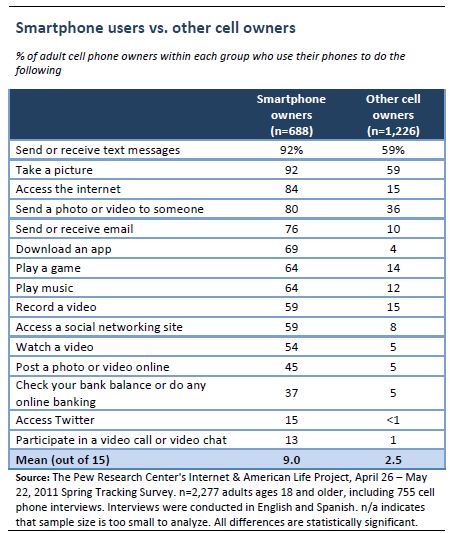Mobile phones have become a near-ubiquitous tool for information-seeking and communicating: 83% of American adults own some kind of cell phone. These devices have an impact on many aspects of their owners’ daily lives. In a telephone survey conducted from April 26 to May 22, 2011 among a nationally-representative sample of Americans, the Pew Research Center’s Internet & American Life Project found that, during the 30 days preceding the interview:
- Cell phones are useful for quick information retrieval (so much so that their absence can cause problems) – Half of all adult cell owners (51%) had used their phone at least once to get information they needed right away. One quarter (27%) said that they experienced a situation in the previous month in which they had trouble doing something because they did not have their phone at hand.
- Cell phones are an important tool in emergency situations – 40% of cell owners said they found themselves in an emergency situation in which having their phone with them helped.
- Cell phones can help stave off boredom – 42% of cell owners used their phone for entertainment when they were bored.
- Despite their advantages, some cell phone owners just need an occasional break – 29% of cell owners turned their phone off for a period of time just to get a break from using it.
- With advantages comes frustration – 20% of cell owners experienced frustration because their phone was taking too long to download something; 16% had difficulty reading something on their phone because the screen was too small; and 10% had difficulty entering a lot of text on their phone.
- Cell phones can help prevent unwanted personal interactions – 13% of cell owners pretended to be using their phone in order to avoid interacting with the people around them.
Young adults (those between the ages of 18 and 29) are especially likely to say that they have encountered several of these situations recently:
- 70% of 18-29 year old cell owners have used their phone for entertainment when they were bored
- 64% have used their phone to quickly retrieve information they needed
- 42% have had trouble doing something because they did not have their phone nearby
- 30% have used their phone to avoid interacting with the people around them
Text messaging and picture taking are the most common uses of cell phones outside of voice calls; Smartphone owners take advantage of a wide range of their phones’ capabilities
Text messaging and picture taking continue to top the list of ways that Americans use their mobile phones—three quarters of all cell owners (73%) use their phones for each of these purposes. Other relatively common activities include sending photos or videos to others (54% of cell owners do this) as well as accessing the internet (44%).
One third of American adults (35%) own a smartphone of some kind%%TOKEN%%, and these users take advantage of a wide range of their phones’ capabilities. Fully nine in ten smartphone owners use text messaging or take pictures with their phones, while eight in ten use their phone to go online or send photos or videos to others. Many activities—such as downloading apps, watching videos, accessing social networking sites or posting multimedia content online—are almost entirely confined to the smartphone population.

Several demographic groups use the non-voice features of their mobile phones at high rates. These include young adults, non-whites, urbanites, and those with at least some college experience.
About this survey
The results reported here are based on a national telephone survey of 2,277 adults conducted April 26-May 22, 2011. 1,522 interviews were conducted by landline phone, and 755 interviews were conducted by cell phone. Interviews were conducted in both English and Spanish. For results based on all adults, the margin of error is +/-2 percentage points; for results based on all cell owners, the margin of error is +/-3 percentage points (n=1,194); and for results based on smartphone owners, the margin of error is +/-4.5 percentage points (n=688).




